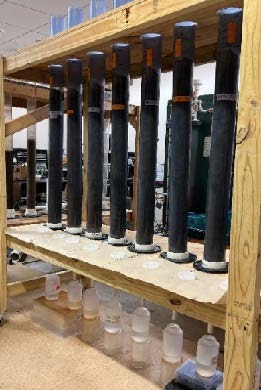Compacted soils exhibit limited root growth in vegetation, reduced infiltration, and water storage, resulting in increased stormwater runoff. Biochar amended soils are a potential remedy to this issue. The addition of carbon enriched amendments such as biochar can enhance soil hydraulic properties including wet aggregate stability, water capture and hydraulic conductivity. Furthermore, biochar can be incorporated into roadside stormwater control measures (SCMs) to improve water quality, decrease pollutant infiltration, and decrease runoff. However, there is substantial variability in biochar performance based on feedstock, pyrolysis temperature, soil properties, and biofilter design. In this project, eleven different biochar supplies were used as amendments within two different North Carolina clay soils. Variations in physicochemical properties, including sieve analysis, hydrometer analysis, pycnometer density, dry bulk density, methylene blue adsorption capacity, and heavy metals analysis were analyzed. Additionally, hydraulic properties were evaluated through tests for water retention and saturated and unsaturated hydraulic conductivity. Soil-amended biochar samples were then evaluated for their contaminant removal properties for nutrients, indicator bacteria, and heavy metals through batch tests. Results of the physicochemical and batch testing were used to select the biochar samples that would be utilized in a year-long column study.

Overall, several studies displayed increased contaminant removals which compared to the control (soil-only column), and their effectiveness generally decreased overtime. Outcomes of the laboratory study were aggregated into a biochar vendor webtool that juxtaposes ordering information with generalized laboratory results for each biochar to aid future selection of biochar products for field studies and applications. Contaminant removal efficiencies were also integrated into a triple bottom line (TBL) workbook developed to visualize scenario-based costs and benefits (economic, environmental, and social) for green infrastructure with and without biochar amended soils. The performance data, webtool, and TBL workbook can be used to procure biochar supplies, select biochar type based on desired outcomes, and evaluate tradeoffs between potential costs and benefits of future biochar-amended green infrastructure
projects.
